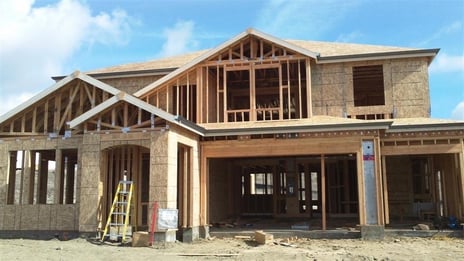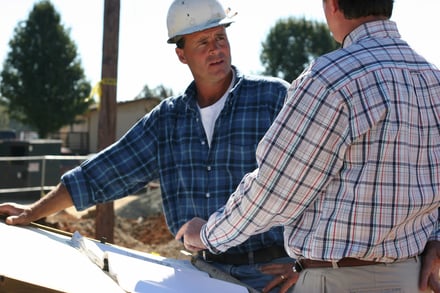Radon Gas and New Construction
If you are in the process of building a new home, there are lots of things to consider, but have you thought about Radon Gas and the impact it can have on you and your family?
Table of Contents
- What is Radon?
- Radon Gas Entry
- Options for Radon Removal During the Building Process
- Passive Radon System
- Contact a Licensed Professional
- Schedule a Discounted Radon Test
Radon is a radioactive gas that comes from the soil and rock that our homes are built on. Radon is the second leading cause of lung cancer in the United States, second only to smoking. There are roughly 21,000 deaths per year that are caused by radon-related lung caner.
Radon naturally occurs from the breakdown of uranium that is found in most rocks and soil. During the breakdown, atomic particles are released. We breathe these in and the can become trapped in our lungs. The particles can then alter a cell's DNA and increase one's risk of contracting lung cancer.
Radon does not present a health risk outdoors because it is diluted by the open air. However, radon indoors will become trapped, and depending upon the soil and rock that your home is built on, you may be living with high concentration levels of this dangerous gas trapped inside your home.
Are some homes more susceptible to radon? Read our blog post: "Which Homes are Most Susceptible to Radon?"

Radon Gas Entry
Radon has the ability to enter a home through cracks in the foundation or any openings such as a sump pump.
The differences in air pressure between inside of the home and the soil around the home can play a part in radon entry as well.
For example, if the air pressure of the house is greater than the soil underneath is, the radon will remain outside of the home. But, if the air pressure of the home is lower than the soil surrounding the home, the house will then act as a vacuum and suck the radon inside the home.
Because radon comes from the soil that your home is built on, and not every home is built on the exact same soil, you will not be able to determine whether your home is safe just because you're building your home in a certain city or neighborhood.
Not sure if you have been exposed to radon? Read our blog post: "How Do You Know if You've Been Exposed to Radon."
Options for Radon Removal During the Building Process
If you're in the process of building a new home, you have a few options to deal with radon gas.
First, you can ask your builder about making your home "radon resistant". This means your builder will utilize the following techniques during the building process:
- Install a layer of clean gravel or aggregate beneath the slab or flooring system of the home.
- Lay polyethylene sheeting on top of the gravel layer.
- Include a gas-tight venting pipe from the gravel level through the building to the roof.
- Seal and caulk the foundation thoroughly
- Install an electrical junction box within reachable distance of the radon vent pipe. This will allow for an electrical source in the event the system is activated.
Your builder should consult with a licensed radon mitigation company to make sure they install the "passive" radon system properly.
The system is known as passive until a ventilation fan is attached, which may or may not be necessary depending upon the radon levels in your home.
Determining the exact radon levels will not be possible until the home is finished. Some builders wait until the home is finished, have the home tested and then decide if they want to install the whole system at once.
Others choose to have the passive system installed during the building process. In some cases the passive system will not need the fan added and will work fine on its own, while in other cases the fan does need to be added to reduce the radon levels even further. However, if that is the case, the fan can be added quite easily because the majority of the system has already been installed.
There is no right or wrong way to do this as long as the builder is away that they may have a potential radon problem and the home will need to be tested upon completion of the build.
If you do decide to have the passive system installed during the building process of your home, it's important to remember that this may not solve your problem entirely.
Having the home tested once the build is complete will determine your next move. If your radon levels come back at a 4.0 pCi/L or higher, even though you have a passive system, you will need to have the ventilation fan added to try and reduce the levels further.
In many cases the passive system will work just find and no additions will need to be made. You will still need to verify this information to make sure your home is safe.
Contact a Licensed Radon Testing and Mitigation Company
Whether you need a passive system installed during the building process, a ventilation fan added to a passive system, a whole system installed, or your home tested, it's important to hire a licensed company for all of your radon testing and mitigation services.
Radon Companies who are licensed will have gotten the certifications through The Ohio Department of Health. There are rules and regulation for both radon testing and mitigation that need to be followed to ensure accuracy.

If a company is not licensed they may not be following the specified regulations and your home may not be protected properly.
Always ask to see a company's license information before any work is begun. This is your health and your families health on the line, it's important not to cut corners just to save a few bucks.
At Radon Eliminator we have a team of licensed Radon Testing and Mitigation Specialists who have experience to assist with any of your radon service needs.
We have installed passive systems; these systems are activated by installing a ventilation fan, and we have also installed systems from scratch for homes and commercial properties.
We provide discounted radon testing services, and free quotes for any type of installation. We will speak with you and find out what your home needs and give you advise about what steps you should take to ensure the safety of your home.
Contact us today by clicking on the link below and let us know how we can assist with any of your Radon Service needs.





